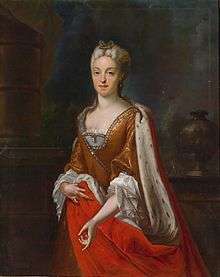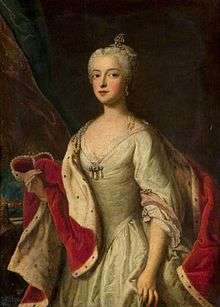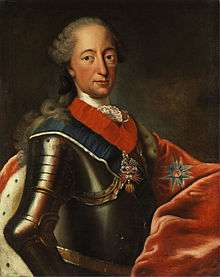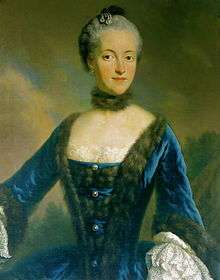Maria Amalia of Austria
| Maria Amalia of Austria | |||||
|---|---|---|---|---|---|
|
Holy Roman Empress, German Queen, Queen consort of Bohemia Electress consort of Bavaria | |||||
 | |||||
| Holy Roman Empress Queen of the Germans | |||||
| Tenure | 12 February 1742 – 20 January 1745 | ||||
| Queen consort of Bohemia | |||||
| Tenure | 9 December 1741–1743 | ||||
| Electress of Bavaria | |||||
| Tenure | 26 February 1726 – 20 January 1745 | ||||
| Born |
22 October 1701 Hofburg Palace, Vienna, Archduchy of Austria, Holy Roman Empire | ||||
| Died |
11 December 1756 (aged 55) Nymphenburg Palace, Munich, Electorate of Bavaria | ||||
| Burial | Theatine Church | ||||
| Spouse | Charles VII, Holy Roman Emperor, Elector of Bavaria | ||||
| Issue |
Maria Antonia, Electress of Saxony Princess Theresa Benedicta Maximilian III, Elector of Bavaria Maria Anna, Margravine of Baden-Baden Maria Josepha, Holy Roman Empress | ||||
| |||||
| House |
House of Habsburg (by birth) House of Wittelsbach (by marriage) | ||||
| Father | Joseph I, Holy Roman Emperor | ||||
| Mother | Duchess Wilhelmine Amalia of Brunswick-Lüneburg | ||||
| Religion | Roman Catholicism | ||||
Maria Amalia of Austria (Maria Amalie Josefa Anna; 22 October 1701 – 11 December 1756) was Holy Roman Empress, Queen of the Germans, Queen of Bohemia, Electress and Duchess of Bavaria etc. as the spouse of Charles VII, Holy Roman Emperor. By birth, she was an Archduchess of Austria as the daughter of Joseph I, Holy Roman Emperor and Wilhelmine Amalia of Brunswick-Lüneburg.
Maria Amalia had seven children with her husband Charles, only four of whom lived through to adulthood. Her son became Maximilian III, Elector of Bavaria. Her youngest daughter Maria Josepha married the eldest son and heir of Maria Theresa, Emperor Joseph II, but died, childless, of smallpox after two years. Another daughter, Maria Antonia, married her first cousin, Frederick Christian, who was Prince-elector of Saxony for less than three months in 1763. Her middle surviving daughter Maria Anna Josepha Augusta became Margravine of Baden-Baden.
Family
Maria Amalia was born an Austrian Archduchess in Hofburg Palace, Vienna; about eleven weeks after the death of her infant brother Leopold Joseph, her parents' only son. Her mother was unable to conceive more children after Maria Amalia, supposedly because her father had contracted syphilis from one of his mistresses and passed the disease to his wife, rendering the Empress infertile. Maria Amalia's father had a long line of mistresses, both servants and nobles, and several illegitimate children. Her mother Wilhelmine Amalia of Brunswick-Lüneburg was the sister of the Duchess of Modena and a very pious woman.
When Maria Amalia was nine years old, her father died of smallpox and was succeeded as Holy Roman Emperor by his brother Charles VI. Charles ignored a decree signed during the reign of their grandfather Leopold I that gave her and her sister precedence in succession as the daughters of Leopold's eldest son. Instead, he promulgated the Pragmatic Sanction of 1713, which replaced Maria Amalia and her sister Maria Josepha with his own daughter Maria Theresa in the line of succession. The displaced archduchesses were not allowed to marry until they renounced their rights to the Austrian succession.
Marriage
Maria Amalia was proposed as a bride for the Italian Prince of Piedmont, heir to the Kingdom of Sicily and Duchy of Savoy. The union was supposed to create better relations between Savoy and Austria, but the plan was ignored by the Duke of Savoy. The younger Victor Amadeus subsequently died of smallpox, unmarried, in 1715.
In 1717, Maria Amalia met her future spouse, Charles of Bavaria, who visited Vienna on his way to participate in the war against the Ottoman Empire in Belgrade. He used the time to become acquainted with the Imperial family, and wished to marry in to the Habsburg dynasty for dynastic and economic reasons. They met a second time in 1718. Charles initially asked to marry her elder sister Maria Josepha, but she was already engaged at the time of his proposal. Maria Amalia and her sister Maria Josepha were both given a very strict Catholic upbringing with focus on Catholic religious duties by their mother, but Maria Amalia were described as a more vivid and extrovert personality than the more serious Maria Josepha.
Having agreed to recognize the Pragmatic Sanction, Maria Amalia married Prince-Elector Charles of Bavaria on 5 October 1722 in Vienna. The opera I veri amici ("The True Friends") by Tomaso Albinoni was performed at the wedding.[1] Maria Amalia received a grand dowry, including jewelry worth 986.500 gulden, but outside the religious festivities, the wedding was not celebrated as much in Vienna as it would be in Münich, where they lasted from 17 October to 4 November.
They lived at Nymphenburg Palace in Munich and had seven children. At the birth of the heir in May 1727, Maria Amalia was given her own residence, the Fuerstenried Palace as a gift, and in 1734, Charles named the Amalienburg in the Nymphenburg Palace Park after her. Similar to her mother, she was forced to accept the infidelity of her spouse: her husband also had six illegitimate children. However, their relationship is described as a moderately happy one, as they had similar personalities and interests. Like Charles, she enjoyed court life, pomp and parties, and together they made the Bavarian court a cultural center. Maria Amalia was interested in politics, had a passion for hunting and managed to engage also in her interest for travels with the argument that pilgrimages would make it easier for her to give birth to sons. She protected churches and convents and had a close relationship with her sister-in-law Maria Anna, who as a member of the Poor Clares in München. She liked the opera and her apartments at the royal Münich residence is regarded as a notable example of the rococo.
Despite the fact that she had renounced her claims to the Austrian lands upon her marriage, Charles claimed the Habsburg lands by marriage to her during the War of the Austrian Succession in 1740. After an agreement with the spouse of her elder sister Maria Josepha, who would otherwise have a stronger claim than her, Charles invaded Bohemia. Maria Amalia was crowned as Queen of Bohemia in Prague 7 December 1741. On 12 February 1742, Maria Amalia became Holy Roman Empress following her husband's coronation as Holy Roman Emperor in Frankfurt, where she herself was crowned as Empress consort. On 14 February, however, Bavaria was occupied by Austria.
Death
Maria Amalia's husband died on 20 January 1745 and was buried at the Theatine Church in Munich. On his death, she persuaded her son Maximilian to make peace with her cousin Maria Theresa. As a widow, she mainly resided at Fuerstenried Palace. In 1754, Maria Amalia founded a medical hospital, managed by the nuns of the Elisabetinerinnen, whom she invited to Münich. This is counted as the first modern hospital in the city.
Maria Amalia died in Munich at the Nymphenburg Palace.
The following anecdote is from the fifth volume of Casanova's History of My Life:
- The confessor, who was a Jesuit, received me as badly as possible. He said in passing that my reputation was well known in Munich. I asked him firmly if he was telling me this as good news or bad, and he did not answer. He simply walked away, and a priest told me that he had gone to verify a miracle of which all Munich was talking. "The Empress," he said, "the widow of Charles VII, whose body is still exposed to public view, has warm feet though she is dead." He said that I could go and see the wonder for myself. Most eager to be able to boast at last that I had witnessed a miracle, and one which was of the greatest interest to me since my feet were always icy, I go to see the illustrious corpse, which did indeed have warm feet, but it was because of a hot stove which stood very near her defunct Imperial Majesty.
Issue
| Name | Portrait | Birth | Death | Notes |
|---|---|---|---|---|
| Maximiliane Maria Princess of Bavaria |  | 12 April 1723 | Died in infancy. | |
| Maria Antonia Walpurgis Electress of Saxony |  | 18 July 1724 | 23 April 1780 | Married in 1747 Frederick Christian of Saxony, had issue. |
| Theresa Benedicta Princess of Bavaria |  | 6 December 1725 | 29 March 1743 | Died young and unmarried. |
| Maximilian III Joseph Elector of Bavaria |  | 28 March 1727 | 30 December 1777 | Married in 1747 Maria Anna Sophia of Saxony, no issue. |
| Joseph Ludvig Leo Prince of Bavaria |  | 25 August 1728 | 2 December 1733 | Died in infancy. |
| Maria Anna Josepha Margravine of Baden-Baden |  | 7 August 1734 | 7 May 1776 | Married in 1755 Louis George, Margrave of Baden-Baden, no issue. |
| Maria Josepha Antonie Holy Roman Empress |  | 30 March 1739 | 28 May 1767 | Married in 1765 the Joseph, King of the Romans, no issue. |
Ancestry
References
- ↑ A new chronology of Venetian opera and related genres, 1660-1760 by Eleanor Selfridge-Field, p. 367
- Johann Jakob Moser: Geschichte und Thaten des Kaysers Carl des Siebenden unpartheyisch beschrieben und mit Anmerckungen erläutert, 1745
- Constantin von Wurzbach: Habsburg, Maria Amalia (deutsche Kaiserin). In: Biographisches Lexikon des Kaiserthums Oesterreich. Band 6, Verlag L. C. Zamarski, Wien 1860, S. 22.
- Peter Claus Hartmann: Karl Albrecht – Karl VII., 1985, ISBN 3-7917-0957-7
- Gerhard Hojer: Die Amalienburg, 1986, ISBN 3-7954-0710-9
- Alois Schmid: Maria Amalia, Erzherzogin von Österreich. In: Neue Deutsche Biographie (NDB). Band 16, Duncker & Humblot, Berlin 1990, ISBN 3-428-00197-4, S. 175 f. (Digitalisat).
- Rudolf Reiser: Karl VII., 2002, ISBN 3-934036-87-2
- Andrea Rueth: Maria Amalia. In: Jürgen Wurst, Alexander Langheiter (Hrsg.): Monachia. Städtische Galerie im Lenbachhaus, München 2005, ISBN 3-88645-156-9, S. 146.
External links
| Wikimedia Commons has media related to Maria Amalia of Austria. |
| German royalty | ||
|---|---|---|
| Preceded by Theresa Kunegunda Sobieska |
Electress of Bavaria 1726–1745 |
Succeeded by Maria Anna of Saxony |
| Preceded by Elisabeth Christine of Brunswick |
Holy Roman Empress, German Queen 1742–1745 |
Succeeded by Maria Theresa of Austria |
| Queen consort of Bohemia 1741–1743 |
Succeeded by Maria Luisa of Spain | |